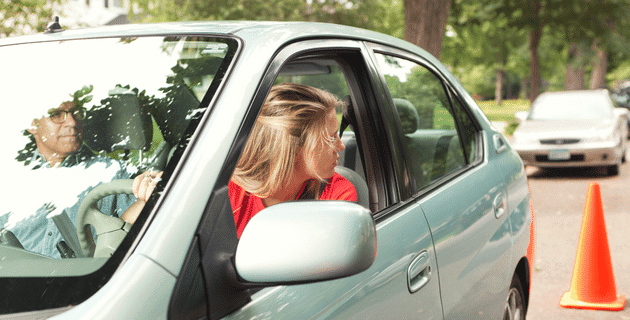
by California Casualty | Auto Insurance Info |
Teaching your child to drive can be exciting and emotional, and you want it to go as smoothly as possible. If you’re getting ready to slip into the passenger seat alongside your teen, remember, you’ve got this. In honor of Teen Driver Safety Week, we’ve put together a guide to help.
Tip #1: Remember there is no common sense for new drivers.
Your teen is used to zoning out on car rides, maybe listening to music on headphones or playing with his/her phone. As a result, teens may not even know familiar routes. They also probably won’t understand the impact of some decisions that they make behind the wheel. Before you even get in the car, prepare your young driver for the road.
-
- Make sure your son or daughter knows the special driving rules for teens in your state, such as curfews and number of passengers allowed.
- Show your teen where the car’s registration and insurance are kept.
- Set the rules to minimize distracted driving. If you allow the radio or other music, make sure it’s set before you drive. Avoid eating while driving. Keep cell phone use for emergencies only.
- Discuss when your teen should pull over to the side of the road, such as when he or she is drowsy or when ambulances or police cars sound their sirens.
- Note that there are rules of the road to follow, and sometimes being nice (e.g. braking hard on a major road to let a car in) is an unexpected move that could cause an accident.
Tip #2: Practice in the parking lot.
Remember that basic driving skills are natural to you but new to your child. Take the time to practice in a low-pressure environment, such as an empty parking lot. Spend at least three 45-minute sessions with your teen in the lot before moving on to other driving scenarios.
-
- Practice adjusting and using side and rearview mirrors.
- Remember to look where you want to go.
- Start and stop smoothly. Experiment with stopping distances based on speed.
- Understand the vibrations of the anti-lock braking system which can startle drivers.
- Practice driving on the right side of the road and making turns into the correct lane.
- Pull into parking spots and back out.
Tip #3: Build skills slowly.
Slowly progress to roadways requiring different levels of driving skill. Spend at least 2 hours each on the following areas before moving on to the next level.
On neighborhood roads, practice:
-
- The position of your car on roads with and without lines.
- Turning right and left, with and without stop signs.
- Giving the right of way.
- Parking at the curb including parallel parking.
On easy main roads, practice:
-
- Lane changing (check mirrors, then signal, check blind spot and then change lanes).
- How far back a car is in reality based on how it looks in the mirror.
- Right of way at intersections.
- Sharing the road with other vehicles, pedestrians, and bicycles.
- Using the shared left turning lane to exit the road.
On high-speed main roads, practice:
-
- Lane changing at high speeds (different in feel from changing at low speeds; less steering required).
- Merging onto a high-speed road.
- Negotiating traffic circles and U-turns.
On highways, practice:
-
- Merging onto a highway from an entrance ramp and exiting on an exit ramp.
- Using mirrors to merge and change lanes.
- Which lane to use for which purpose (e.g. left is the passing lane).
- How to identify your location if your car breaks down on the highway.
Tip #4: Lead by example.
Your son or daughter may inherit your driving habits, so make sure to model the behavior that you want to see. As your teen becomes more comfortable driving, he or she may become critical of your driving habits. Use those as teaching opportunities.
When you drive:
-
- Enter the GPS destination before you leave.
- Wear your seatbelt.
- Don’t text and drive. Don’t eat and drive. Don’t drink and drive.
- Don’t speed.
When your teen drives:
-
- Respect your teen as an adult. Don’t micromanage the driver.
- Avoid high levels of emotion. That can create fear. Anticipate dangers and discuss them calmly before you reach them.
- Remember to praise your teen for a job well done.
Make sure that your car is well maintained and fully insured with your teen listed on the policy. Talk to your insurance agent about ways that you can save with a teen driver.
This article is furnished by California Casualty, providing auto and home insurance to educators, law enforcement officers, firefighters, and nurses. Get a quote at 1.866.704.8614 or www.calcas.com.
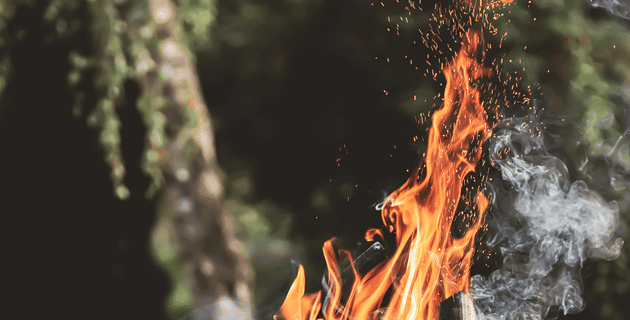
by California Casualty | Homeowners Insurance Info |
It takes just about 30 seconds for a small fire to turn into a major blaze. That same fire can destroy your home in minutes. Spending some time to fireproof your home, inside and out, can help to protect it. Fireproofing can also buy you precious time if you need to escape your home and get to safety.
Whether it’s a fire that accidentally started in your home or a wildfire in your area that could affect you, the following guide lists ways to reduce the risks.
Inside Your Home
The kitchen is a common place for fires to start while we’re cooking.
-
- Clean the grease and oil on your stovetop and around your stove. These oil deposits are fuel for a fire.
- Avoid storing things above or around the stove that can catch fire, such as pot holders, paper towels, and wooden spoons. Make sure flammable cleaning chemicals are stored safely away, too.
- Stay in the kitchen when you’re cooking. Don’t leave your home with the oven on.
- If a fire occurs in the kitchen, cover the flames and remove it from the heat. Don’t douse it with water. That can cause an explosion of oil. See our blog for tips on how to prevent and handle cooking fires.
Electrical outlets can only handle a certain amount of power. Overloading them can lead to a fire.
-
- Don’t overload outlets. Limit the use of extension cords. Don’t plug too many appliances into one outlet.
- Unplug appliances (coffee maker, toaster) when not in use.
- Plug large appliances directly into wall outlets, not into extension cords.
- If you’re constantly tripping the breaker or blowing a fuse, you’re either overloading your outlets or you may have something wrong with your electrical system. Get it checked out.
Space heaters can sometimes spark a fire. Position them carefully.
-
- Place your space heater on a hard non-flammable and level surface.
- Keep space heaters at least 3 feet away from anything that can burn.
- Avoid putting heater cords where they can be pinched by furniture, under rugs, or carpets.
- Turn off the heater and unplug it when you leave the room or go to bed.
Pro Tip: Choose a space heater with an automatic shutoff safety switch if it is overheated or tipped over.
Dryers are filled with dust, fibers, and lint that is fuel for fires.
-
- Clean the lint filter in your dryer before each use.
- Check the air vent pipe at least once a year and remove built-up lint.
- Clothes stained with chemicals or cooking oil should not be put into a hot dryer, even after a wash cycle. Use the lowest setting.
Smoke detectors and fire extinguishers are your best defense in the event of a fire.
-
- Install a smoke detector in each bedroom and in areas outside bedrooms. Make sure there is at least one on every floor.
- Test batteries every month. Change batteries twice a year. Replace smoke alarms at least every 10 years.
- Get a fire extinguisher and keep it in an easily accessible location. Make sure it is an ABC-rated extinguisher that is good for fires involving combustible materials, flammable liquids, and electrical equipment.
If you’re planning a home improvement project, consider fire doors and fire-resistant flooring.
-
- Fire doors can hold flames and smoke back, giving you time to escape.
- Synthetic and wool carpets spread fire. Fire-resistant carpets slow down the spread.
- You can also treat your carpet with flame retardants.
Outside Your Home
Depending upon the material, roofs and siding can catch fire. Chimneys also can ignite.
-
- You may not have a choice in the material of your roof. But if you do, choose fireproof options such as tile, metal, or concrete.
- Similarly, choose materials like stucco or stone for siding. If you must use wood, paint it with a fire-resistant coating.
- Embers can enter through openings. Cover soffit vents and gable end vents with 1/8-inch wire mesh.
- If you have a chimney, get it professionally inspected and cleaned once a year. The buildup that sticks to the inner walls is flammable.
Clogged gutters filled with leaves, branches, and other debris are flammable.
-
- Clean your gutters regularly and consider gutter guards to keep debris out.
- Choose metal gutters rather than vinyl ones that can melt during a fire.
Windows can break when exposed to extreme heat.
-
- Install dual pane window glass, which is thicker and can last longer than traditional glass in a fire. These windows are also energy-efficient and can save you money.
- Windows are usually framed in wood, which can be a way for fire to enter your home. Instead, frame windows in metal.
- Replace nylon window screens, which may melt, with metal screens.
- Consider nonflammable shutters, which are similar to hurricane shutters.
When doing home improvement projects, choose materials that are fire-retardant.
-
- Replace wood decks with tile, concrete, brick, or stone.
- Use fire-resistant materials, when possible, with your projects. Examples include gypsum boards, perlite boards, calcium or sodium silicates, treated fibers (cotton, hemp, flax), treated lumber, brick, concrete, and cement.
Fire prevention starts in the yard. Create a border around your home that is fireproof.
-
- Get rid of flammable vegetation and replace it if desired with fire-resistant plants. Examples include California lilac, ornamental strawberry, French lavender, California Fuchsia. These plants are high in moisture content.
- Similarly, plant fire-resistant trees such as cherry, birch, and poplar.
- Replace mulch with gravel. Mulch is highly flammable while gravel is not.
- Consider paving with stone or concrete to create an additional barrier.
Trees could fall and carry the fire danger right to your home.
-
- Trim trees near your house so that fiery branches will have fewer chances to drop on your roof.
- Downed power lines are electrical fire hazards. If your trees are growing between the power lines, report them to your power company, which may come and trim them for you.
Water can be effective in slowing down a fire.
-
- Invest in fire sprinklers which release water when they detect fire. (These are also available for the interior of the home.)
- Wet down your deck, bushes, and grass if you are anticipating a wildfire danger.
Make sure you have home insurance that protects against damage caused by accidental fires and wildfires. The right insurance provides peace of mind in the event of a fire.
If you’d like to learn more, see our blog about fire zones and what they mean for your home.
This article is furnished by California Casualty, providing auto and home insurance to educators, law enforcement officers, firefighters, and nurses. Get a quote at 1.866.704.8614 or www.calcas.com.
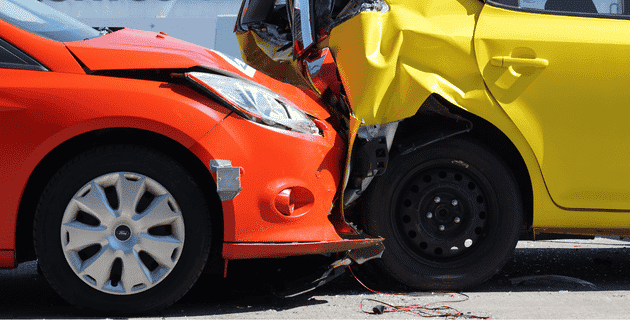
by California Casualty | Auto Insurance Info, Safety |
The open road, the sunshine, and vacation time—it seems that summer is meant for road trips. With so many of your fellow travelers on the road, though, there’s a chance for collisions. That’s especially true if you’re on a long drive, on unfamiliar roads or distracted by confusing signs, or even the passengers in your car.
So, how do you avoid a vacation-spoiling accident? Knowing the most common summer collisions – and their causes – can help you take action to avoid them. Here’s what you need to know.
Rear-end Collisions
These common types of collision can be caused by tailgating or distracted driving during stop-and-go traffic. Rear-end collisions also happen when motorists drive too fast or aggressively. To avoid a rear-end collision:
-
- Slow down and watch your speed.
- Increase your following distance between your vehicle and the car in front.
- Avoid stopping suddenly or swerving.
- Make sure your taillights and turn signals are working.
Pro Tip: If your car has one, an automatic braking system or forward collision warning system can help prevent these types of accidents.
Front-end Collisions
When the front end of your vehicle strikes another vehicle, tree, telephone pole, or other object, it’s a front-impact collision. These types of crashes are common during rainy weather. To avoid a front-end collision:
-
- Drive more slowly in the rain. Roads are slippery. Fog can impair your vision. Give yourself time to adjust.
- Increase your following distance in inclement weather. This will help give you more time to react.
- Avoid distractions; even playing with the radio or talking to passengers can divert your attention.
- Lane keeping systems can help. They alert you when you’re drifting out of lane, and can even steer your car back into the lane.
Side-impact Collisions
You know these as T-bone collisions or sideswipes. They often occur at intersections, as a result of confusion about which vehicle has the right of way. However, they also can occur if you run a red light or change lanes without warning. To avoid a side-impact collision:
-
- Look both ways as you approach a stoplight. Slow down when you see yellow; don’t speed up. You could risk running a red light.
- Come to a complete stop at every stop sign. Know where other traffic is before proceeding.
- Check your blind spot before changing lanes.
- When passing cars, be alert for other drivers changing lanes unexpectedly.
Highway Construction Collisions
Construction crews are out on the roadways, often sharing space with vehicles traveling at high speeds. That’s why it’s especially important to watch for signage and adjust your speed as you navigate past a construction site. To avoid a highway construction collision:
-
- Pay attention to construction site speed limits and follow them.
- Watch for signage and personnel directing you where to go.
- Slow down as you are passing workers and be alert.
- Increase your following distance for the car in front of you.
Interstate Collisions
High speeds coupled with distracted, aggressive, or drowsy drivers can cause accidents. When a crash happens on the highway, it can sometimes have a chain reaction effect. Make sure to use due diligence when you’re traveling at high speed around other vehicles. To avoid an interstate collision:
-
- Follow the speed limit and maintain a safe following distance from other drivers.
- Clearly indicate with your turn signal when you wish to change lanes. Check your blind spot before doing so, and make sure cars in other lanes aren’t heading to the same place you are.
- Maintain your distance from cars that are driving aggressively or dangerously.
- Limit distractions. Your priority is to drive safely.
Parking Lot Collisions
We may not think about it, but parking lots can be dangerous. When the lot gets busy, it’s easy to have multiple cars moving in different directions. Inattention or simply a bad decision can cause a collision. To avoid a parking lot collision:
-
- If possible, park in a spot away from other cars.
- Check your surroundings before getting into your car to pull out of your parking space.
- Don’t rely on technology alone (such as rearview cameras). The image can be distorted by sunlight or shadows. Use your mirrors.
- Move slowly and be aware of pedestrians and cars in the immediate area.
- Don’t drive when you’re drowsy. If you’re feeling tired or having a hard time staying awake, pull over in a safe place and take a power nap.
- Don’t use your cell phone when driving except for emergencies.
- Don’t eat or drink anything in spillable containers while you’re driving.
- Don’t drive when you’ve had a few drinks. Use a designated driver or call a ride-share service instead.
- Avoid driving during high traffic times.
- Take your car in for a maintenance checkup before you go on a road trip. This will help avoid equipment-related accidents.
Finally, make sure your car is insured so you are fully covered in case of an accident.
Safe travels!
This article is furnished by California Casualty, providing auto and home insurance to educators, law enforcement officers, firefighters, and nurses. Get a quote at 1.866.704.8614 or www.calcas.com.
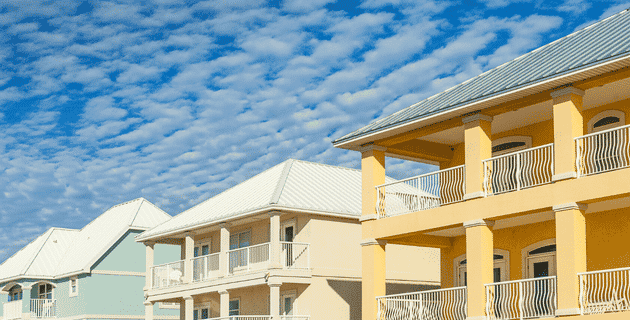
by California Casualty | Homeowners Insurance Info |
You’re going on vacation and renting a beautiful property for the week. You’re not expecting anything to go wrong, but what happens if something does? What if you break something, or if you get injured? What if your stuff gets damaged or stolen?
Read on to find out the answers to common questions about insurance coverage for vacation rentals. Knowing what to expect before your vacation will help you make sure you’re covered.
What if something happens to my stuff?
You went out to dinner and came home to find your stuff stolen—a vacation surprise no one would want. Fortunately, your homeowner’s policy or a renter’s policy (at your permanent residence) can help. Your policy will cover your property for 16 named perils or occurrences (i.e. fire, theft, explosion) subject to special limits. However, if your property is damaged because you dropped it or your child spilled juice on it, there is no coverage.
Personal property coverage is that part of your policy that protects your possessions. If they are stolen, or damaged by fire/smoke or other covered “perils” anywhere in the world, your policy will pay for them. That’s true whether your belongings are at your primary home, in your car, or with you on vacation. There are dollar limits for certain items such as money, jewelry, and firearms, so check with your insurer. For personal property coverage on a homeowner’s policy, you typically get 50 or 75% of Coverage A, the total amount of coverage for your home. Renters get to choose the amount of personal property coverage.
How will you be compensated? It depends what you selected for your policy: replacement cost or actual cash value (ACV). ACV is the amount the item is worth, minus depreciation for its age. It will cost a little more for a policy that provides replacement cost since that is higher than ACV. You will get reimbursed minus the amount you have chosen for your deductible, the amount you pay out-of-pocket before your insurance company pays a claim. That’s why all of these decisions when you set up a policy are so important.
What happens if you get hurt at your vacation rental?
Maybe you were minding your own business, and preparing snacks for your day at the beach when a loose tile in the kitchen caused you to trip and fall. As a result, your vacation included a visit to Urgent Care. In this case, the owner of the rental property might reimburse you for your medical bills under Coverage F – Medical Payments To Others of their Property Policy. At California Casualty, we pay the necessary medical expenses that are incurred or medically ascertained within three years from the date of an accident. This coverage however does not involve negligence or liability. After all, the rental property owner didn’t know about the loose tile.
Pro Tip: Because the rental property owner’s policy is the one that would cover medical expenses, make sure that they have coverage.
What happens if you damage the property during your stay?
Let’s say you accidentally put a hot pan on the kitchen counter and the resulting mark doesn’t come off (oops!). You’ll need to pay for the repair. It’s the same if you place the plan there and intentionally caused the damage. The only time your homeowner’s policy will pay for a place that you rent, and do not own, is for property damage caused by fire, smoke, or explosion. Of course, it cannot be intentional.
Are you insured for vacation homes outside the country?
Your homeowner’s or renter’s personal property coverage protects your belongings when they are with you wherever they are. Similarly, your homeowner’s or renter’s liability coverage protects you from damage that you may cause to others or their property anywhere in the world.
When should you file a homeowner’s insurance claim?
If the damage is greater than your deductible, you may wish to file a claim. If it’s not, or if the difference is not much, you may to decide to pay out-of-pocket rather than going through insurance. For example, if the damage if $1,500 and your deductible is $500, you could file a claim. However, if the damage is $750 and your deductible is $500, you may decide to pay the difference. Know that filing a claim can cause your premiums to rise over time.
In addition, some vacation rentals charge a security deposit to cover any damage. Check with your prospective rental so you’ll know going in what to expect.
Finally, talk to your insurance agent and do a policy review to make sure you are fully covered for your vacation rental and other summer fun.
This article is furnished by California Casualty, providing auto and home insurance to educators, law enforcement officers, firefighters, and nurses. Get a quote at 1.866.704.8614 or www.calcas.com.
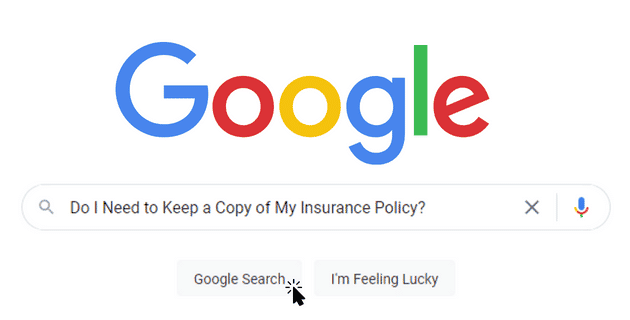
by California Casualty | Auto Insurance Info, Homeowners Insurance Info |
If you’ve ever sat down to read a declaration page on an insurance policy, you know there’s a lot that goes into the documentation. This information is clearly important, but there’s a lot of paperwork. Do you really need to keep it all, and for how long?
Here’s a quick reference guide for your insurance paperwork, including how to organize it, store it, and for how long.
Insurance Policy
Whether you have home insurance, an auto policy, a renter’s policy, or another type of coverage, you will be issued a document that spells out the insurance coverage. This main policy document is multiple pages. It includes all the details of your policy, including coverages and limits, discounts, and endorsements. It also is a resource with definitions of insurance terms and explanations of the claims process. If you are bundling your coverages, such as with home and auto, you will have an insurance policy document for each.
You need to know the coverage that you have, but you don’t necessarily need a hard copy of your policy document. If your insurer offers digital access on their website, you can toss the paper version. Either way, you will want to keep a hard copy of the declarations page.
Certificate of Insurance (COI)
This document is the summary of your coverage. Its format is easy to scan and provides a quick look at your coverage details. It’s especially useful to share with lenders who require proof of insurance if you are financing your home or car.
Keep a copy of your certificate of insurance for as long as the policy is active. It is your proof of insurance. When you renew your policy, you can throw out the old COI.
Insurance Claims Documents
Accidents happen, and things get damaged and stolen. You may file a claim with your insurance company when this happens. If your claim is for an auto policy, you will get an accident report. You also may have medical reports and bills. If your claim is for home damage or theft, you will have an inventory of damage. You also will have repair bills, receipts, and other paperwork. If it’s a third-party claim, where you caused injury or loss to another person, you will receive documentation as well.
Claims can sometimes take years, especially if medical bills are involved. As long as your claim is open, keep all of the paperwork. Only throw it out after you have received the payment.
Vehicle Insurance Card
Your auto insurance card fits in your wallet or glove compartment, which is where it should be kept. That way, you have a hard copy even if you have access to a digital version. Hard copies are useful in case you are pulled over by law enforcement or need to exchange the information with another driver in the event of an accident.
Keep the hard copy of your auto insurance card as long as your policy is active. You may dispose of it when the policy renews and you receive a new card.
Billing Statements
You will receive regular billing statements from your insurer, usually monthly. These may be by mail or online.
Keep your billing statements for tax purposes if you have a home business or you use your car for business purposes. If you’re audited by the IRS, you may need to show your bills for the last 7 years.
How to Store Documents
If you’re keeping paper copies of documents, you want to make sure that they remain in good, readable condition. Here are some recommendations to keep them that way:
-
- Never store your important papers in a basement in case of flooding.
- Keep your documents in a safe container in a climate-controlled space to reduce the possibility of mold and fading.
- Store papers in a waterproof and fire-resistant container. Consider a home lock box or safe or a filing cabinet.
- Consider digital storage as well, as a backup. You can store copies of papers on a flash drive. For a small fee, you also can store them in Dropbox and on iCloud and other services.
Pro Tip: Use plastic page sleeves for your documents for added protection. You can slide your documents into the sleeves and then file them in a binder or box.
How to Dispose of Documents
The general rule is that once a policy is done, you don’t need to keep the paperwork. (See the exceptions for claims documents and billing statements above.) But your insurance documents have personal information that could lead to identity theft if not disposed of safely.
-
- Always shred any old papers. Use a crosscut shredder that cuts in two directions to produce confetti.
- A small home shredder will work or you may find a free shredding event in your community.
- Local banks and other companies also may shred your papers for a fee.
- Remember to permanently delete old digital copies as well.
Going Paperless
Did you know, you can access your account online with California Casualty? Once you’ve signed up, you will have quick access to your policy(ies) at any time and from anywhere. You simply “Sign In” in the same right-hand corner where you created your account initially. And easy, secure access to this policy portal gives you the flexibility to:
-
- Download/Print ID Cards
- View/Download Your Declaration Pages
- Pay Your Bill Online
- Make Some Changes to Your Policy (Manage Drivers, Manage Vehicles, Manage Lienholders/Mortgagee)
- Contact Customer Service for Additional Support
- File a Claim
- Create/Save a New Auto Quote, etc.
Click here to learn more.
This article is furnished by California Casualty, providing auto and home insurance to educators, law enforcement officers, firefighters, and nurses. Get a quote at 1.866.704.8614 or www.calcas.com.





